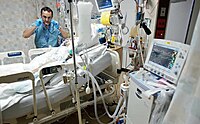
Photo from wikipedia
PURPOSE Despite the importance of training in ambulatory care settings for residents to acquire important competencies, little is known about the organizational and environmental factors influencing the relative amount of… Click to show full abstract
PURPOSE Despite the importance of training in ambulatory care settings for residents to acquire important competencies, little is known about the organizational and environmental factors influencing the relative amount of time primary care residents train in ambulatory care during residency. The authors examined factors associated with postgraduate year 1 (PGY1) residents' ambulatory care training time in Accreditation Council for Graduate Medical Education (ACGME)-accredited primary care programs. METHOD U.S. accredited family medicine (FM) and internal medicine (IM) programs' 2016-2017 National Graduate Medical Education (GME) Census data from 895 programs within 550 sponsoring institutions (representing 13,077 PGY1s) were linked to the 2016 Centers for Medicare and Medicaid Services Cost Reports and 2015-2016 Area Health Resource File. Multilevel regression models examined the association of GME program characteristics, sponsoring institution characteristics, geography, and environmental factors with PGY1 residents' percentage of time spent in ambulatory care. RESULTS PGY1 mean (standard deviation, SD) percent time spent in ambulatory care was 25.4% (SD, 0.4) for both FM and IM programs. In adjusted analyses (% increase (standard error, SE)), larger faculty size (0.03% (SE, 0.01), P < .001), sponsoring institution's receipt of Teaching Health Center (THC) funding (6.6% (SE, 2.7), P < .01), and accreditation warnings (4.8% (SE, 2.5), P < .05) were associated with a greater proportion of PGY1 time spent in ambulatory care. Programs caring for higher proportions of Medicare beneficiaries spent relatively less time in ambulatory care (<0.5% (SE, 0.2), P < .001). CONCLUSIONS Ambulatory care time for PGY1s varies among ACGME-accredited primary care residency programs due to the complex context and factors primary care GME programs operate under. Larger ACGME-accredited FM and IM programs and those receiving federal THC GME funding had relatively more PGY1 time spent in ambulatory care settings. These findings inform policies to increase resident exposure in ambulatory care, potentially improving learning, competency achievement, and primary care access.
Journal Title: Academic Medicine
Year Published: 2020
Link to full text (if available)
Share on Social Media: Sign Up to like & get
recommendations!